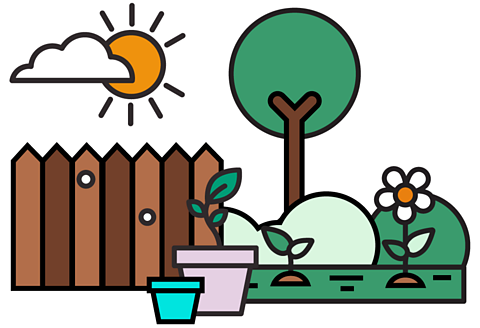
Welcome to The Regenerators.
Produced in partnership with The Open University
Career profile
Meet Tayshan, a garden designer from London.
Tayshan discovered gardening after the Grenfell Tower fire in 2017 for the way it helped to bring his community back together.
Find out about Tayshan’s passion for green spaces and how garden design can improve biodiversity in urban areas.
Tayshan: My name is Tayshan, and I'm a footballer and a garden designer.
I design gardens, but I also run a nonprofit with the aim of improving access to green spaces for everyone.
I actually came to gardening after Grenfell happened. I discovered it was something that can really bring a community together, and that's why I started a nonprofit focused on empowering young people through horticulture, but also creating a more inclusive environment.
I'm really passionate about influencing garden designs to improve biodiversity. I want to green up more spaces to encourage bees, butterflies and pollinators to thrive because they're so important.
They pollinate one third of our food.
Living in central London is very congested, and actually there are very innovative ways of greening up spaces, looking at green malls, quirky ways of growing like hydroponics, which means growing plants without soil.
So this is great in urban environments where space is limited. There are so many ways that we can grow our foods more sustainably, more locally and seasonally.
I didn't have any formal gardening training when I started designing gardens. At the age of twenty four, I decided to go back to college and get some horticultural qualifications. I got my level one, which took about seven months, and it was part time, so I went to college once a week, and then I did level two and completed that this year.
I would say that practical experience is the most important thing. It's all about giving things a go. All the Latin names and technical terms in horticulture can be quite overwhelming. But actually, when you go into a garden and you plant something in the ground, it's the most beautiful feeling.
You don't quite realise how many jobs and careers there are in horticulture. Even the football pitches that I play on someone mows the lawn and grows the pitch and is the caretaker of that ground. And that's actually a really tough skill, but it's a very well-paid job.
They're also maintenance gardeners, tree surgeons and garden designers like me.
You don't need to get bogged down by the theory of gardening. Actually, you learn from mistakes. I've killed many basil plants in my kitchen. But then I learn maybe if you do this and you do that, the basil plant might survive and you can enjoy many pastas in the future.
If you are interested in horticulture, why don't you take a trip down to your local community garden where you can have a chat, volunteer and learn things about plants. Get stuck in and you never know where it will take you.
I would say practical experience is the most important thing, it’s all about giving things a go. All of the Latin names and technical terms in horticulture can be quite overwhelming, but actually when you go into a garden and plant something in the ground it’s the most beautiful feeling.
Tayshan, garden designer
- Tayshan was a rising football star, but decided to go to college at 24 years old to study horticulture.
- As well as designing gardens, Tayshan has set up his own non-profit organisation which focuses on empowering and inspiring young people through horticulture, while making it more inclusive.
- He studied for his Level 1 part-time and has recently been awarded a Level 2 Diploma in horticulture.
Green spaces

Gardens and spaces relax us, look good, smell nice and enhance our health and wellbeing.
Growing fruit and vegetables locally saves money and carbon emissions.
Trees and plants help us deal better with climate extremes by providing shade, absorbing heat and soaking up water during storms.
They also clean the air and provide nectar to feed our endangered pollinators.

Salary and hours

The information below relates to a gardener, a role that shares some similar responsibilities.
- Gardener salary: £16,000 to £25,000 average per year
- Gardener working hours: 38 to 40 hours per week

Entry requirements

You can become a gardener through a college course, apprenticeship, by working towards the role or direct application.
Diploma or Certificate: There are levels of Diplomas or Certificates in horticulture. Relevant courses include:
- Level 1 Certificate in horticulture skills - usually requires two or fewer GCSEs at grades 3 to 1 (D to G), or equivalent.
- Level 2 Diploma in practical horticultural skills - usually requires or more GCSEs at grades 9 to 3 (A* to D), or equivalent.
- Level 3 Certificate or Diploma in horticulture - usually requires four or five GCSEs at grades 9 to 4 (A* to C), or equivalent
Apprenticeship: You could also become a gardener through an apprenticeship. For example through a horticulture and landscape operative intermediate apprenticeship. For this you might need some GCSEs, or equivalent, usually English and maths. For advanced apprenticeships you might require five GCSEs, or equivalent, at grades 9 to 4 (A* to C).
Working towards - You could also start as an assistant gardener. It can be useful to get some experience of gardening by volunteering with conservation organisations or horticultural groups. This will help demonstrate your skills and knowledge of gardening.
This information is a guide (sources: National Careers Service)
For careers advice in all parts of the UK visit: England, Northern Ireland, Scotland and Wales

There's more to learn
Explore more careers with BBC Bitesize and The Open University.
More from The Regenerators
BBC BITESIZE




